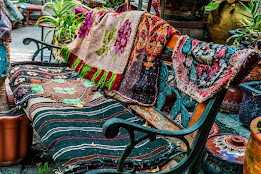Bohemian Design Style & Its Connection With India
Bohemian Design Style & Its Connection With India
Today's design world, it’s people, and their lifestyles are trying to adapt to the Bohemian design style in a modern way because of its unique aesthetics and adjustable dimensions of a design scale, even if the style has carried a lot of design clutter and more is more formula with different colors and patterns. The style has a strong and age-old history, but with confusion and sometimes even controversy.
This article is to make some sense of the confusion, see what was the history behind it, and what influences the Bohemian style what it is today.
Definition of terms
Merriam-Webster dictionary has the following to say :
- An unconventional way life for bohemians
Bohemian
-The Czech dialect group used in Bohemia
-A person (such as an author or an artist) who usually lives an unconventional life in a colony with others-
A Romani person
What is Bohemianism and Bohemian?
The bohemian
style is known for its distinctive features such as lots of colors, patterns,
patchwork, coziness, clutter, and things
like rustic or vintage but the style got all these features from its history.
In the early 19th century, the word Bohemianism emerged in France, when artists and creators began to focus on lower-rent, lower-class Romani communities. It means an unconventional lifestyle of impoverished and constant
travelers, artists, writers, journalists, musicians, and actors in major
European cities.
Bohemian refers
to a resident of the former Kingdom of Bohemia, now known as the Czech
Republic. And another meaning derived from the French word
referring to Romani people or gypsies, a person living a socially
unconventional life, In particular, one who is involved in the arts.
Who are the Romani or Gypsy people?
A Gypsy is
another name of Romani people because Europeans believed that they had migrated
to the country from Egypt due to their dark skin and dark hair. But Romani
people are also known as Roma originates from the northern Indian subcontinent, from the Rajasthan, Haryana, and Punjab regions of modern-day India. This is an Indo-Aryan ethnic
group, living mostly in Europe, especially Central, Eastern, and Southern
Europe after that America, the former Soviet Union,
West Asia, and North Africa. There is an approximate population of at
least 20 million Romas worldwide.
Also, this ethnic group traveled from India to Europe, and because of this migration, there is an impact of Mexican design, Zen spirituality, and the things which are inspired to develop the Bohemian style.
The connection between Romani people and India
Romani people have migrated from India around the 6th and 11th centuries, but exactly when and why they had migrated this is an uncertain timeline since there is no hard evidence. They have been associated with another traditionally itinerant ethnic group originated in India called Doma people. These two groups have been separated from each other but they have shared a similar history.
The language spoken by the current Roma people was originated from Indo-Aryan regional languages such as Hindi, Punjabi, Marwari, and Bengali. The Romani language shares much of its basic pronunciation and some words with these languages.
Also, the DNA evidence proves that the Romani people are of Indian descent, it means basic or original Romani population, which still have not genetically mixed with native European population, this shares a lot of the physical traits which are common to native Indian population such as skin and hair color, cultural & traditional similarities.
The Bohemian/ Roma Peoples Style Connection With Indian Style
Bohemian style is not exactly like Indian style whether it is fashion design or interior design, but it has similar features like Indian style have such as multiple colors (bold, natural), different types of patterns (floral, traditional patterns or clean lines), vintage and traditional esthetic furniture, more natural material, vivid details and decorations, and lots of textures.
Factors That Contribute And Inspired To The Bohemian Style Of Decoration
- The Romani/ Gypsy people’s way of life and their roots from where they came
- 19th Century’s Bohemianism term
- The 60s and 70s
period of Bohemian style
- The creative
approach towards art and life
- 1960’s Hippie
Movement- Carefree and spiritual vibes
- Respect and concern for the environment
Features of Bohemian Interior Style
- Maximalism is the formula
- The chaos of colors and patterns
- Travel inspiration such as bags, world globe, and maps are included in the decoration
- Vintage furniture such as rustic metal and wood furniture
- Creative decor such as hand-crafted decoration
- Globally inspired artwork and furniture pieces
- Mismatched look
- Love and admiration for nature
Travel Inspiration Like Van Decoration, Bags Are To Showcase Travel Things, Glob & Maps To Inspire The Travel
Bold And Multiple
Colors, Patterns & Texture Fabric Or Textile To Give Freedom &
Happiness Of Life
Bohemian Hand-Crafted Colorful & Eco-Friendly Decoration
The Romani People Are India’s Pride: India Is The Romani People’s Pride
There are maybe some Indian nationals who fail to accept their Indian ancestry, but members of the Roma community around the world have always been proud of their Indian roots and their linguistic and cultural connection with their motherland.
After reading the complete article you can relate our topic that shows the connection between
India, Romani people/ Gypsy, and Bohemian style. It will help you to add more
information about Bohemian style, its history, and its design sense with all the logics that
bring this style out of the box.






















Comments
Post a Comment